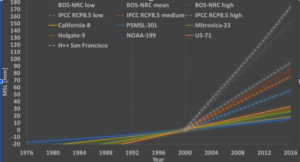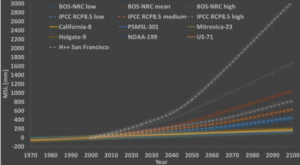Sea levels: A reality of stability vs. the growing fantasies
By Albert Parker & Clifford Ollier
In our latest work [1] of title “CALIFORNIA SEA LEVEL RISE: EVIDENCE BASED FORECASTS VS. MODEL PREDICTIONS” we demonstrated the growing inconsistency between the tide gauge measurements and the models by the Intergovernmental Panel on Climate Change (IPCC), and local Californian boards, for example, [2] and [3]. The ocean levels have been for the most part oscillating about an almost linear pattern since the begin of the twentieth century up to this point. If the IPCC prediction of up to 0.85 m sea level rise by 2100 is already an exaggeration, the forecast by the Californian boards of up to 1.67 meters and lastly up to 3.05 meters are just a proof that there is no constraint to the climate change deception. The difference amongst models and reality is increasing as opposed to being lessened.
As discussed in [1], different data sets of tide gauges show relatively small “trends” and negligibly small “accelerations”:
+0.862±0.487 mm/year and +0.012±0.046 mm/year2 “PSMSL-199” data set (global, range >60 years),
+0.49±0.34 mm/year and +0.0063±0.0263 mm/year2 “PSMSL-162” data set (global, range >80 years),
+1.61±0.21 mm/year and +0.0020±0.0173 mm/year2 “Mitrovica-23” data set (long term stations, high quality),
+1.77±0.17 mm/year and +0.0029±0.0118 mm/year2 “Holgate-9” data set (long term stations, high quality),
+1.000±0.458 mm/year and +0.005±0.041 mm/year2 “NOAA-199” data set (global, range>60 years, no quality check);
+0.40±0.27 mm/year and +0.0090±0.0208 mm/year2 “NOAA-120” data set (global, range>80 years, one quality check passed);
+2.123+0.549 mm/year and -0.008±0.049 mm/year2 “US-71” data set (US only, range>60 years, no quality check),
+1.63±0.23 mm/year and +0.0021±0.0192 mm/year2 “US-39” data set (US only, range>80 years, one quality check passed),
+1.19±0.29 mm/year and +0.0014±0.0266 mm/year2 “California-8” data set (long term stations, high quality);
Figure 1 is a comparison of sea level measurements vs. sea level computations over the time window 1970 to 2016, and Figure 2 is an evidence based forecast to the year 2100 vs. the model predictions. The tide gauge measurements translate in forecasts to 2100 of 100-200 mm sea level rise, not certainly the 850 mm by the IPCC, nor the 1,670 or the 3,050 mm by [2] and [3].
Fig. 1 – Comparison of sea level rises predicted by the local panels [2] (BOS-NRC) and [3] (H++), predicted by the IPCC AR5 RCP8.5 (IPCC RCP8.5), and measured by the tide gauges (averages of different data sets, California-8, PSMSL-301, Mitrovica-23, Holgate-9, NOAA-199, US-71). Further details in [1].
Fig. 2 – Comparison of sea level rises by 2100 predicted by the local panels [2] (BOS-NRC) and [3] (H++), predicted by the IPCC AR5 RCP8.5 (IPCC RCP8.5), and inferred from tide gauge measurements of different data sets (California-8, PSMSL-301, Mitrovica-23, Holgate-9, NOAA-199, US-71). Further details in [1].
[1] Parker, A. & Ollier, C.D., CALIFORNIA SEA LEVEL RISE: EVIDENCE BASED FORECASTS VS. MODEL PREDICTIONS, Ocean and Coastal Management, Ocean & Coastal Management, Available online 19 July 2017, In Press, Corrected Proof. doi: 10.1016/j.ocecoaman.2017.07.008
http://www.sciencedirect.com/science/article/pii/S0964569117303071
[2] Board, Ocean Studies, and National Research Council “Sea-level rise for the coasts of California, Oregon, and Washington: past, present, and future.” National Academies Press, 2012
[3] Griggs, G, Árvai, J, Cayan, D, DeConto, R, Fox, J, Fricker, HA, Kopp, RE, Tebaldi, C & Whiteman, EA (California Ocean Protection Council Science Advisory Team Working Group). Rising Seas in California: An Update on Sea-Level Rise Science. California Ocean Science Trust, April 2017.




